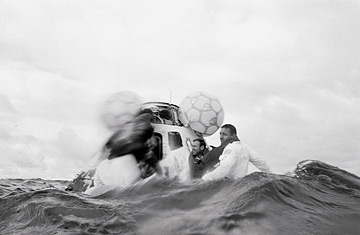
Apollo 13 astronauts on an inflatable life raft as they await their recovery helicopter
April 13, 1970 — Not only was this one of NASA's high moments, it was one of the highest. Here's a syllogism every astronaut knows: Space pilots are test pilots; test pilots die; therefore, space pilots will die. The key is not to be one of them. That means that when you find your ship augering in, you find a way to pull out of it. No one at NASA had even simulated a failure in which the command module is disabled by an explosion, and the crew has to abandon ship for the lunar module; that would be somewhat like teaching student drivers what to do if they find their car hurtling through the air, over a cliff. They die is what they do. Such is the technological free fall that the Apollo 13 crew found itself in, and yet the preternaturally cool Jim Lovell — the first man to fly twice to the moon — and his rookie crew of Jack Swigert and Fred Haise pulled out of it and came home. With the help of Mission Control, they figured out how to conserve their consumables (oxygen, water, power and time), fly their ship manually and build new hardware on the spot out of paper, plastic wrap and, famously, duct tape. None of the three would fly in space again — nor would they need to. Nothing could exceed what they had achieved already.